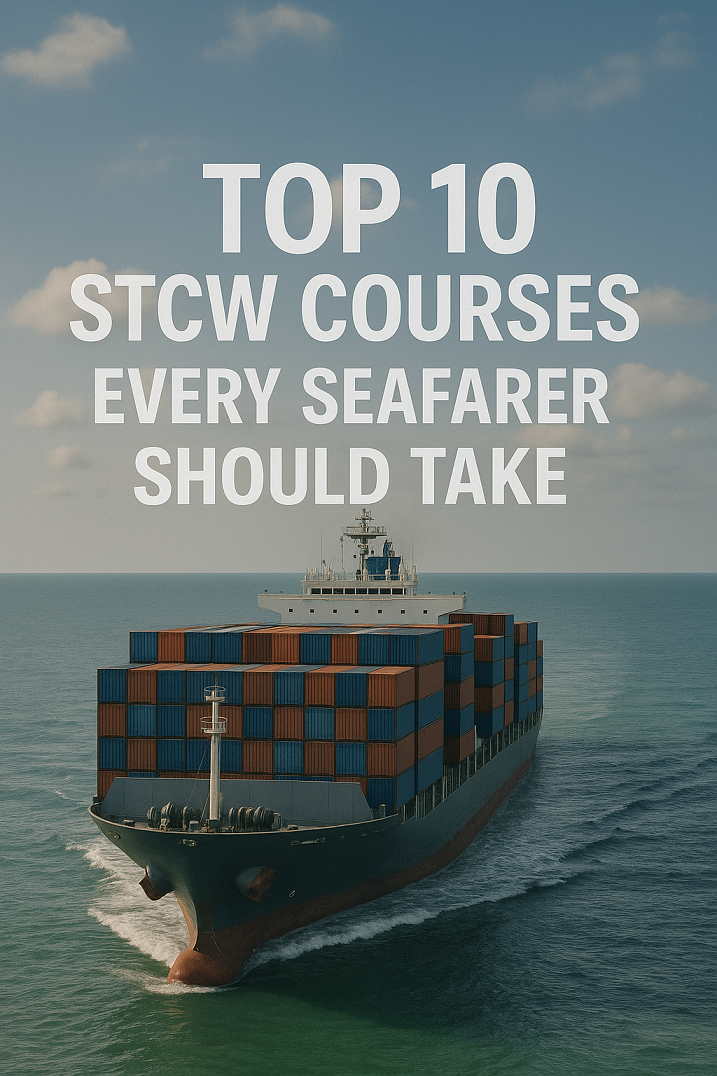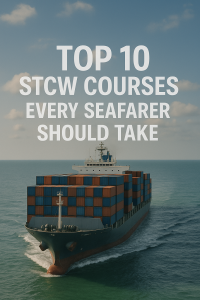Discover the top 10 STCW courses every seafarer should take. Learn which maritime training programs are mandatory, career-enhancing, and essential for safety and compliance at sea.
Why STCW Certification Matters in Modern Maritime Operations
For seafarers, training isn’t optional—it’s lifesaving. The sea is one of the most dynamic and hazardous workplaces on Earth. Whether navigating stormy waters, battling engine failures, or responding to onboard fires, seafarers must be prepared for everything. The IMO’s Standards of Training, Certification and Watchkeeping (STCW) Convention ensures just that.
Established in 1978 and amended multiple times (most notably the STCW 2010 Manila Amendments), the STCW sets global standards for:
- Safety training
- Watchkeeping competence
- Emergency response
- Medical care
- Security awareness
With IMO regulations, flag states, and port authorities requiring STCW-compliant documentation, mastering these courses is essential for compliance, employability, and crew safety.
This guide covers the top 10 STCW courses that every seafarer—whether cadet, officer, or engineer—should take to succeed at sea.
1. STCW Basic Safety Training (BST)
BST is the foundation for every seafarer’s safety skill set and is mandatory for all crew members, regardless of rank or function.
It Includes Four Modules:
-
Personal Survival Techniques (PST)
-
Fire Prevention and Firefighting (FPFF)
-
Elementary First Aid (EFA)
-
Personal Safety and Social Responsibilities (PSSR)
Duration: Typically 5–6 days
Validity: 5 years (with refreshers required)
Real-World Relevance: Whether responding to a fire in the engine room or abandoning ship, BST prepares seafarers for survival.
2. Proficiency in Survival Craft and Rescue Boats (PSCRB)
Required for deck officers and any crew assigned to lifeboat duties, PSCRB ensures competence in launching and operating rescue crafts.
Covers:
-
Lifeboat launching and handling
-
Survival techniques in adverse weather
-
Man overboard rescue procedures
Scenario: During the Costa Concordia disaster in 2012, lifeboat deployment failures emphasized the importance of PSCRB training.
3. Advanced Firefighting (AFF)
Mandatory for officers and crew with firefighting responsibilities, this course prepares participants to lead fire control teams, use breathing apparatus, and understand fire behavior on ships.
Skills Gained:
-
Commanding fire response operations
-
Controlling ventilation and flammable liquids
-
Communicating with bridge and emergency teams
Duration: 4–5 days
Use Case: Engine room fires, galley blazes, cargo hold flare-ups.
4. Medical First Aid and Medical Care
This course is essential for officers on ships without a dedicated medical professional. It builds upon Elementary First Aid and includes:
-
Diagnosing and treating common illnesses
-
Managing fractures, burns, and cardiac events
-
Coordinating with shore-based medical assistance
IMO Reference: STCW Code A-VI/4-1 and A-VI/4-2
Vital Insight: Delayed medical treatment is one of the top contributors to fatal incidents at sea—making this training indispensable.
5. Security Awareness and Designated Security Duties (ISPS Code)
Under the ISPS Code, seafarers must understand security threats, terrorism risks, and anti-piracy measures. Two course options exist:
-
Security Awareness (A-VI/6-1): For all seafarers
-
Designated Security Duties (A-VI/6-2): For crew assigned specific security roles
Topics Include:
-
Threat recognition and reporting
-
Access control procedures
-
Ship Security Plans (SSP)
Recent Context: In piracy-prone waters like the Gulf of Guinea or Red Sea, trained crew are critical in reducing hijack risk.
6. Bridge Resource Management (BRM)
BRM is not a “safety” course in the traditional sense—but it’s essential. It trains navigators and deck officers to:
-
Communicate effectively
-
Manage workload and decision-making
-
Use bridge equipment collaboratively
Based on: IMO Model Course 1.22
Objective: Prevent accidents due to poor coordination or human error—the leading cause of ship collisions.
7. Engine Room Resource Management (ERM)
Like BRM for navigators, ERM is for engineers. It promotes safe engine room operations through teamwork, leadership, and systems thinking.
Focus Areas:
-
Communication in emergencies
-
Load-sharing under pressure
-
Situational awareness in multi-machine environments
Relevant For: All engineer officers and watchkeeping personnel.
8. Oil and Chemical Tanker Familiarization
Required for seafarers working on tankers, this course familiarizes crew with:
-
Hazardous cargo characteristics
-
Vapor control systems
-
Spill response protocols
Governing Code: STCW A-V/1-1
Advanced Training: Separate modules exist for chemical and liquefied gas tanker personnel.
Case in Point: The Erika and Prestige oil spills catalyzed global demand for trained tanker crews.
9. Crowd Management and Crisis Leadership (Passenger Ships)
For those working on passenger vessels, these courses train seafarers to:
-
Assist passengers during emergencies
-
Communicate clearly during evacuations
-
Manage panic and coordinate crowd flow
Required Under: SOLAS Chapter V
Essential For: Cruise ship officers, ferry crew, and ro-pax operators.
10. Leadership and Teamwork Skills
This course, aligned with IMO Model Course 1.39, develops:
-
Conflict resolution
-
Cultural awareness
-
Ethical decision-making
With multinational crews being the norm, leadership training ensures onboard harmony, productivity, and mission success.
–
Case Study: How STCW Training Saved Lives During the Norman Atlantic Fire (2014)
When the Norman Atlantic ferry caught fire in the Adriatic Sea, trained crew managed to coordinate lifeboat deployment, passenger communication, and emergency signals under extreme pressure. Investigations concluded that STCW-trained personnel were instrumental in preventing a much higher death toll.
FAQ: STCW Courses for Seafarers
Q1: Are STCW courses mandatory for all seafarers?
A: Yes. At a minimum, all crew must complete Basic Safety Training (BST). Additional courses depend on rank, vessel type, and assigned duties.
Q2: How often do I need to renew STCW certificates?
A: Most have a 5-year validity. Refresher courses are required to maintain compliance, especially for fire and survival modules.
Q3: Can I complete STCW courses online?
A: Some theoretical modules (e.g., security awareness) can be completed online, but practical modules require in-person assessment.
Q4: Are STCW courses globally recognized?
A: Yes. Courses completed at IMO-approved maritime training centers are accepted by all signatory countries.
Q5: How much do STCW courses cost?
A: Costs vary by country and provider. A complete BST package typically ranges from $500 to $1,500 USD depending on location.
Conclusion
STCW courses form the backbone of global maritime safety and professionalism. Whether you’re a cadet embarking on your first voyage or an experienced officer advancing your career, these top 10 STCW courses will shape your competence, confidence, and credibility.
As the industry evolves toward greener ships, autonomous systems, and stricter safety regulations, continuous training remains non-negotiable. These courses aren’t just regulatory requirements—they’re tools for survival and leadership at sea.
Call to Action: Ready to start or upgrade your maritime career? Browse accredited STCW courses and enrollment guides at our Maritime Training Portal.
References
-
International Maritime Organization. (2023). STCW Convention and Code. https://www.imo.org
-
ICS. (2022). Training and Certification in the Shipping Industry. https://www.ics-shipping.org
-
UK MCA. (2023). STCW Course Guide and Requirements. https://www.gov.uk
-
BIMCO. (2022). Best Practices in Crew Training and STCW Compliance. https://www.bimco.org



Simply want to say your article is as amazing. The clarity on your publish is just cool and that i can think you are a professional in this subject. Fine with your permission let me to grab your RSS feed to keep updated with coming near near post. Thank you 1,000,000 and please carry on the enjoyable work.